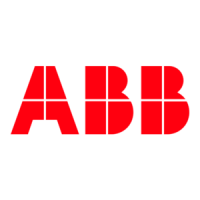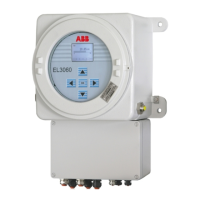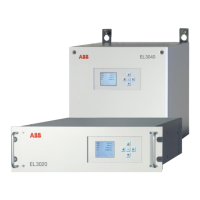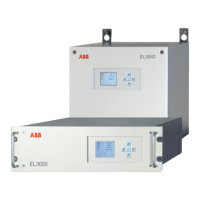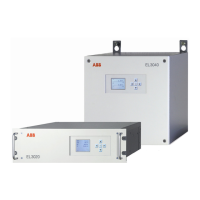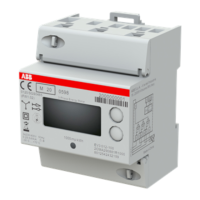Do you have a question about the ABB EL3060 Series and is the answer not in the manual?
Outlines the fundamental sequence of actions for installing and commissioning the gas analyzer.
Defines the intended use and application scope for the EL3060 gas analyzers.
Covers personnel qualifications, observed regulations, national rules, device safety, and explosion hazard prevention.
Details risks of disconnected protective leads, opening covers, working with open devices, capacitors, battery, and gas supply.
Specifies installation according to IEC/EN 60079-14 and equipotential bonding requirements.
Covers avoiding electrostatic charging, monitoring equipment, and procedures for working on installations and circuits.
Outlines customer duties for ensuring secure network communication with the gas analyzer.
Details active services, Modbus/PROFIBUS protocols, and access credential management.
Lists EC Type Examination Certificates and IECEx Certificates of Conformity for ATEX compliance.
Details compliance with EN 61010-1 for electrical safety and overvoltage categories.
Covers interference immunity and emitted interference compliance with EN 61326-1.
Specifies requirements for the installation site, air circulation, protection from adverse conditions, and climatic conditions.
Defines acceptable sample gas composition, oxygen content, and limits for atmospheric conditions.
Covers equipotential bonding, risks of disconnection, non-detachable lines, and cable routing.
Details Uras26 connecting cables, shielded leads, separate laying, unused glands, and power supply checks.
A checklist to ensure correct installation before putting the gas analyzer into operation.
Details the steps for starting up the analyzer, including warm-up durations and final calibration check.
Guides on setting the computer's IP address and testing the Ethernet connection using ping.
Describes starting communication, receiving, sending, and saving configuration data between the analyzer and computer.
Explains manual/automatic calibration control, status signals during calibration, and current signal behavior.
Covers alarm values, plausibility checks, warm-up phase, and atmospheric pressure effects on calibration.
Details methods for starting (cyclic, external) and disabling automatic calibration.
Describes setting automatic calibration parameters via configurator and instrument.
Covers activation, cycle time, next calibration date/time, combined calibration, and output response settings.
Step-by-step guide for performing zero-point calibration for sample components.
Guides on performing end-point calibration, with and without calibration cells for Uras26.
Explains how measuring range switch-over works and the rules for combining measuring ranges.
Details manual, automatic, and external methods for measuring range switch-over and configuration.
Describes how to configure range limits and autorange thresholds using the ECT software.
Shows how to configure digital inputs/outputs for measuring range switch-over and feedback signals.
Details parameters for setting alarm values, including limit active, component, direction, hysteresis, delay, and confirmation.
Outlines the process for updating the gas analyzer's software using the ECT tool.
Details receiving data, backing up configuration, and initiating the software update process.
Confirms software overwriting, completion of upload, and analyzer restart after update.
Details steps for configuring sample components and printer output settings for QAL3 monitoring.
Explains how to configure data storage parameters, including number of entries and warning settings.
Warns that tasks require special training and may involve working with an open, powered-up analyzer.
Details when to perform a calibration reset and what it does to the analyzer's settings.
Step-by-step guide for recalibrating the pressure sensor and the associated status signal.
Explains the dynamic QR code feature for device identification, error diagnosis, and customer communication.
Guides on selecting, scanning QR codes, and lists recommended scanner applications.
Explains status signals like Error, Maintenance request, Maintenance mode, and Overall status.
Describes the meaning of various status icons displayed on the analyzer screen.
Classifies status messages and explains their representation symbols and acknowledgment procedures.
Guides on accessing the message list and detail view for status messages.
Provides a legend for status signals (A, W, F, S) and message categories (a, aQ, aL, iQ).
Provides troubleshooting steps for various status messages, including boot errors and configuration issues.
Lists troubleshooting for drift errors, calculation errors, and temperature/pressure regulator issues.
Covers troubleshooting for temperature, pressure, flow errors, and chopper wheel issues.
Details troubleshooting for calibration errors, sensitivity issues, and analyzer contamination.
Addresses flow errors (fouled lines, leaks) and unstable measured value display (vibrations).
Covers troubleshooting gas feed path leaks, loss of sensitivity, and Uras26 emitter modulation.
Provides contact details for ABB Service and preparation steps before notifying them.
Lists essential information needed when contacting service, including production number and software version.
Outlines the fundamental sequence of actions for installing and commissioning the gas analyzer.
Defines the intended use and application scope for the EL3060 gas analyzers.
Covers personnel qualifications, observed regulations, national rules, device safety, and explosion hazard prevention.
Details risks of disconnected protective leads, opening covers, working with open devices, capacitors, battery, and gas supply.
Specifies installation according to IEC/EN 60079-14 and equipotential bonding requirements.
Covers avoiding electrostatic charging, monitoring equipment, and procedures for working on installations and circuits.
Outlines customer duties for ensuring secure network communication with the gas analyzer.
Details active services, Modbus/PROFIBUS protocols, and access credential management.
Lists EC Type Examination Certificates and IECEx Certificates of Conformity for ATEX compliance.
Details compliance with EN 61010-1 for electrical safety and overvoltage categories.
Covers interference immunity and emitted interference compliance with EN 61326-1.
Specifies requirements for the installation site, air circulation, protection from adverse conditions, and climatic conditions.
Defines acceptable sample gas composition, oxygen content, and limits for atmospheric conditions.
Covers equipotential bonding, risks of disconnection, non-detachable lines, and cable routing.
Details Uras26 connecting cables, shielded leads, separate laying, unused glands, and power supply checks.
A checklist to ensure correct installation before putting the gas analyzer into operation.
Details the steps for starting up the analyzer, including warm-up durations and final calibration check.
Guides on setting the computer's IP address and testing the Ethernet connection using ping.
Describes starting communication, receiving, sending, and saving configuration data between the analyzer and computer.
Explains manual/automatic calibration control, status signals during calibration, and current signal behavior.
Covers alarm values, plausibility checks, warm-up phase, and atmospheric pressure effects on calibration.
Details methods for starting (cyclic, external) and disabling automatic calibration.
Describes setting automatic calibration parameters via configurator and instrument.
Covers activation, cycle time, next calibration date/time, combined calibration, and output response settings.
Step-by-step guide for performing zero-point calibration for sample components.
Guides on performing end-point calibration, with and without calibration cells for Uras26.
Explains how measuring range switch-over works and the rules for combining measuring ranges.
Details manual, automatic, and external methods for measuring range switch-over and configuration.
Describes how to configure range limits and autorange thresholds using the ECT software.
Shows how to configure digital inputs/outputs for measuring range switch-over and feedback signals.
Details parameters for setting alarm values, including limit active, component, direction, hysteresis, delay, and confirmation.
Outlines the process for updating the gas analyzer's software using the ECT tool.
Details receiving data, backing up configuration, and initiating the software update process.
Confirms software overwriting, completion of upload, and analyzer restart after update.
Details steps for configuring sample components and printer output settings for QAL3 monitoring.
Explains how to configure data storage parameters, including number of entries and warning settings.
Warns that tasks require special training and may involve working with an open, powered-up analyzer.
Details when to perform a calibration reset and what it does to the analyzer's settings.
Step-by-step guide for recalibrating the pressure sensor and the associated status signal.
Explains the dynamic QR code feature for device identification, error diagnosis, and customer communication.
Guides on selecting, scanning QR codes, and lists recommended scanner applications.
Explains status signals like Error, Maintenance request, Maintenance mode, and Overall status.
Describes the meaning of various status icons displayed on the analyzer screen.
Classifies status messages and explains their representation symbols and acknowledgment procedures.
Guides on accessing the message list and detail view for status messages.
Provides a legend for status signals (A, W, F, S) and message categories (a, aQ, aL, iQ).
Provides troubleshooting steps for various status messages, including boot errors and configuration issues.
Lists troubleshooting for drift errors, calculation errors, and temperature/pressure regulator issues.
Covers troubleshooting for temperature, pressure, flow errors, and chopper wheel issues.
Details troubleshooting for calibration errors, sensitivity issues, and analyzer contamination.
Addresses flow errors (fouled lines, leaks) and unstable measured value display (vibrations).
Covers troubleshooting gas feed path leaks, loss of sensitivity, and Uras26 emitter modulation.
Provides contact details for ABB Service and preparation steps before notifying them.
Lists essential information needed when contacting service, including production number and software version.
| Communication | HART, PROFIBUS PA, FOUNDATION Fieldbus |
|---|---|
| Type | Electromagnetic Flow Meter |
| Electrode material | Stainless steel, Hastelloy, Tantalum |
| Lining material | PTFE, PFA, Polyurethane |
| Accuracy | ±0.2% of measured value |
| Fluid temperature | -20°C to +180°C (depending on lining material) |
| Process pressure | Up to 40 bar (depending on size and lining) |
| Output signal | 4 to 20 mA, Pulse, Frequency |
| Power supply | 24 V AC/DC |
| Protection class | IP67 |
| Operating Temperature | -20°C to +60°C |
